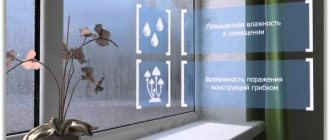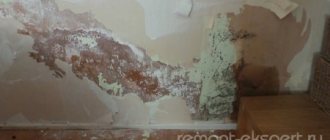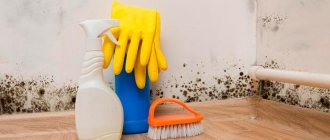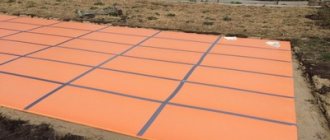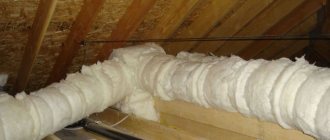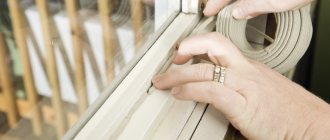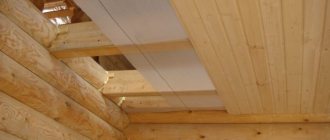Dampness is an ideal environment for the formation and active reproduction of mold fungi on walls. They are dangerous to humans and increase the likelihood of developing allergic and respiratory diseases in adults and children. That is why humidity indicators must be optimal and must be controlled. You can only get rid of dampness in your home through comprehensive actions. Initially, it is worth measuring the humidity level and inspecting problem areas: corners and boards under the main floor covering, and assessing how efficiently the hood works. Then inspect the room and plumbing for sources of moisture. The characteristic odor that appears in a damp room can be combated using traditional methods.
Determining air humidity
This indicator is necessary for a person. If it is below normal, health problems may arise. When levels rise, walls, interior and exterior decoration of the house, furniture, and clothing suffer. These signs indicate that the marks are in an unacceptable range and the problem needs to be addressed.
Hygrometer
The simplest method to obtain accurate readings. A hygrometer is designed to measure the humidity of gases. When choosing a device for your home, you need to pay attention to the error. Its indicator should not exceed 1%. The mechanical device looks like a scale with a pointer, but there are more modern options. You can purchase an electronic apartment thermometer with a built-in hygrometer. Air humidity in the range of 40-60% is considered normal. For the bathroom and kitchen the figure may be slightly higher. If the marks obtained after measurement are higher than normal, it is necessary to establish the reasons for the discrepancy and look for methods to get rid of excess dampness in a separate room or the entire house.
Psychrometric table
A psychometric table is used to determine the humidity level in a room. This method is based on the use of two thermometers (dry and wet). Such a device is called a psychrometer.
To determine the concentration of water in the air, you must adhere to the following algorithm:
- Mark the temperature indicator on paper (remove data from a room thermometer).
- Wrap the end of the thermometer with a damp cloth and take new data after 5-7 minutes.
- If the reading is higher than on a dry thermometer, the material must be moistened additionally and the measurement repeated.
- Record the resulting indicator and compare it with the Assmann table.
- The dry thermometer data is shown in the left column, and the difference between the indicators is in the top line.
- The humidity indicator should be looked for at the intersection of two columns.
If the indicator is low, water from the moistened fabric will evaporate faster, and the temperature will rapidly drop.
Glass of water
This method is not considered accurate, so measurements are recommended if special instruments are not available. Work algorithm:
- Fill a clear glass glass with water.
- Cool the vessel and contents to +5°C. To do this, just keep it in the refrigerator for 3-4 hours.
- Place the container with water away from heating appliances and other heating elements.
- Evaluate the result.
If the walls of the dishes fog up and become dry after 10-15 minutes, the air humidity level in the room is too low. If the fogged walls have not dried, and the drops themselves simply flow into the glass, we can state that the standards have been exceeded. The condensation remaining on the container, which does not flow down the container, indicates that the numbers are within normal limits.
Attention! This test has minimal accuracy; it is impossible to interpret the indicators and obtain a numerical value.
Factors indicating a problem
It is possible to determine a significant excess of the humidity level in an apartment not only using a special device, but also visually.
Mold and mildew appear on the ceiling or walls. Microorganisms multiply at lightning speed in a confined space when the moisture content in the air exceeds 70% and the ambient temperature exceeds 18 degrees.
Mold on the walls
Symptoms of dampness include problems with the condition of the finish: plaster may fall off, wooden materials may rot, or wallpaper may come off the walls.
Condensation appears on plastic windows. The reason may be either manufacturing defects in the structures or problems with the microclimate in the apartment.
Condensation on plastic windows
In addition to the listed problems from dampness in the room, for those in the apartment discomfort will also be caused by an unpleasant odor, which cannot be eliminated with the help of any air fresheners.
Determining the cause of high humidity
You can understand why a private home smells damp by paying attention to the details. Often the problem is noticeable to the naked eye; it can occur under the influence of internal and external factors. Humidity also increases due to improper ventilation or when the integrity of coatings is compromised. Water from the street penetrates inside, but does not evaporate. Until such factors are eliminated, there is no point in making repairs; the violation will return after a while.
Glass test
A simple test using glass will help you understand where moisture comes from in your apartment. It can enter the house from the street, but sometimes the source is indoors. To obtain accurate information, you must perform the following steps:
- Choose a room with the highest level of humidity. One of its walls must be external.
- Take a small piece of glass and attach it to the wall, secure it with tape. It is important to comply with the basic condition - maximum fit, otherwise the data will not be accurate.
- After 3-4 hours, unfasten the glass and evaluate the result.
If the surface adjacent to the wall becomes wet, water penetrates into the apartment from the street. When drops appear on the back side, the source of dampness must be looked for inside the house.
You can understand that the moisture concentration in the air is higher than normal without performing a test. This can be seen if the windows in the room constantly fog up, and the laundry on the dryer does not dry for several days. A simple test with window glass can be carried out in winter, when the difference in air temperature outside and in the room is maximum. It is enough to leave the window closed and turn on the gas burner. If the surface of the glass becomes covered with moisture after a few minutes, there is definitely a problem.
External reasons
Most often, an increase in humidity levels in an apartment or private house is associated with an error at the construction stage of the building. The defect may not appear immediately, but over time due to wear and tear of communications. List of main factors that can affect the level of moisture in the room:
- violation of the tightness of the slabs. Water after precipitation accumulates in the joints of slabs or bricks. This often occurs when the mortar used to attach the cladding dries out and spills out. The integrity of the wall is violated, voids appear in which dampness accumulates;
- flooding. Dampness in the apartment on the first floors appears due to a flooded basement. There may be some water in it, but it will find a way out and rise up if the joints between the wall and the flooring are not sealed. It is possible that the blind area of the house may be destroyed;
- roof leak. Residents of the upper floors face this. The problem rarely occurs immediately. Initially, water enters the stove and accumulates there, which increases the humidity inside the room. Over time, concrete leaks, and water gets directly into the apartment during rain;
- violation of the ventilation device. If the scheme is implemented with errors, the flow of warm air will not be able to escape in full.
Attention! Residents of multi-storey buildings have the right to submit an application to the management company. Housing and communal services workers must establish the exact cause and eliminate it.
Internal reasons
If there are no external defects in the house, the ventilation is working properly, dampness in the apartment can be caused by the following factors:
- leakage of sewerage or central heating pipes;
- violation of window seals;
- hanging wet laundry to dry inside the apartment;
- storing liquids in open containers;
- growing indoor plants and growing flowers in the apartment;
- violation of cooking rules (cooking in an open pan);
- placement of several aquariums in one room of the house.
You can get rid of moisture and dampness if you eliminate these factors. If the problem is growing plants or placing multiple aquariums in a room, it needs to be fixed. Vases with flowers and a tank with fish can be moved to another room, then the indicator will stabilize. It is also worth following the rules when preparing food - do not keep open pots with boiling contents and close containers with household liquids.
Why the walls in the house become wet and how to deal with it
First you need to determine the source of moisture. There may be several options; we will consider each one separately.
Wall freezing
The most common and unpleasant reason for the appearance of moisture on the walls in a room is their freezing. Experts involved in thermal insulation of premises use the term “dew point”. Without going into too much technical detail, this is the temperature at which steam turns into liquid. That is, in our case, condensation will appear on the inner surface.
If the air temperature outside is low and the air in the room is not warm enough, then there is a chance that the wall will freeze. After which moisture will appear on its inner surface. The probability of dampness of the walls indoors is even higher if there are “cold bridges”. Their role can be played, for example, by microcracks in walls or leaky joints in panel houses.
How to deal with damp walls in this case?
Sometimes increasing the room temperature helps. In this case, the “dew point” goes inside the wall. But without unnecessary labor costs, this can only be done in private houses with an autonomous heating system. At the same time, the consumption of gas and money to pay for it will increase. In apartments with central heating, the temperature can only be increased by increasing the number of battery sections.
The most effective way to combat freezing of external walls is their additional insulation. This can be done both from the inside and outside.
Insulating the wall from the inside is considered less labor-intensive. For this, one of the many insulation materials that are commercially available can be used. Most often, polystyrene foam and mineral wool are used for these purposes. Less often - polystyrene foam. Work on internal insulation can be done independently. But this option has a number of significant disadvantages. Firstly, the insulation sheets will “eat up” precious centimeters of room space. And for rooms with dimensions of one and a half dozen squares, this will be noticeable. Secondly, despite all the manufacturers’ statements about the absolute harmlessness of their materials, there is a possibility that harmful fumes will appear in the room. Thirdly, if the thickness of the insulation is incorrectly calculated, it may turn out that the “dew point” will be at the junction between the insulation and the wall. And then you will get a hidden source of moisture and mold formation. The situation is even worse than damp walls in the apartment.
When adding additional insulation to walls, it is better to give preference to exterior work. But, again, such work can be done independently only on the ground floor and in a private house. In all other cases, the involvement of professionals is inevitable.
When insulating walls externally, the heat-insulating material is attached to the wall using special adhesive mixtures and plastic dowels. Then a mesh is laid on top under the plaster and the surface is plastered. After cleaning and sanding, you can begin painting. To prevent moisture from rain and melting snow from getting between the insulation and the wall, a protective canopy made of galvanized metal sheets is mounted along the upper end of the insulation.
The wall gets wet due to insufficient waterproofing
This option, in most cases, applies to those who live on the top or first floors of houses. If the wall is wet below, then moisture can enter from the street through the basement, through the floor, basement, if there is insufficient waterproofing in those places. If the wall in the house gets wet or sweats at the top, most likely moisture enters through the roof, which is poorly insulated from water.
Signs: The largest stains on the walls are in the fall, in damp weather, or in the spring, when the snow begins to melt. If the room is well heated, then at subzero temperatures, wet spots will dry out slowly.
Why does this happen: If the roof is of poor quality, water will always find a loophole and get inside the room. How does it rise to the top if the floor is poorly waterproofed? The fact is that whether it is concrete, brick or building block, all these materials have a very bad property - to absorb moisture. The base, for example, can lift moisture from the ground by almost a meter. This is why waterproofing between the wall of the house and the base is so important.
How to fix: In this case, you have only one way out. Find the place through which water gets inside the wall, and do better waterproofing, or insulate the base from the outside, if this is the case. Inspecting a house from the street will yield more results than looking for a solution from the inside. And of course, ventilation or frequent airing of the room will in many cases reduce the likelihood of problems with wet walls.
Excessive indoor humidity
The simplest reason, in terms of elimination, is high humidity in the apartment. It is possible that the appearance of pockets of dampness was preceded by the replacement of windows in the room. New windows closed the openings more hermetically and worsened the ventilation of the room. In some cases, in order to avoid dampening the walls of the apartment, it is enough just to ventilate the room more often.
If this is not enough, or the problem occurs in a room with potentially high humidity, for example, a kitchen, then you can try to improve the quality of ventilation. To do this, you can put a fan on the vent. Thus, ventilation will turn from natural into forced supply and exhaust with greater productivity.
Insufficient ventilation
The reason for damp walls in rooms with high humidity is poor ventilation. We're talking about the bathroom and kitchen. The performance of the ventilation is determined by opening the window and placing a piece of paper on the vent grille. If the leaf sticks to the ventilation grille, air exchange is not impaired. If paper falls, the ventilation is not working and requires cleaning.
Recent renovation
Partitions often become wet after recent renovation work. This is the most harmless reason. There is no need to eliminate it; it disappears on its own over time. The slight humidity inside the apartment after renovation is easy to explain.
The cement mortar used contains water. Poor ventilation, plus damp weather, affects the rate of moisture evaporation. Therefore, worries about humidity are unfounded.
Additional reasons
Additional reasons include insufficient heating of the room, too thin walls, formation of voids in floor slabs, etc.
Often, dampness in a home is caused by improper foundation insulation . If its waterproofing is insufficient, then if groundwater rises by more than 1.5 meters, it can penetrate the walls. In this case, the manifestation of excess moisture will be observed under the baseboards, the plaster will begin to fall off, and the wallpaper will peel off.
Sometimes you can see how only the upper corners become damp. This problem occurs more often in the cold season. In private houses or apartments on the top floors, dampness occurs due to the attic. This happens when:
- Wetting can occur due to improper attic insulation. Most often, damp spots appear in those places where the attic floor is adjacent to the external walls.
- Poor attic ventilation. If the ventilation system works well, then the temperature remains at the same level over the entire roof surface in cold weather.
Ways to eliminate external causes
The owner himself will have to deal with dampness that appears under the influence of external factors in a private home. If dampness occurs in an apartment, it must be eliminated by housing and communal services workers. When high humidity is formed due to a combination of several violations during the construction of a house, an integrated approach will help to remove it. It is necessary to check all the “modules”, assess the condition of the basement, roof and walls, ensure waterproofing, and then make cosmetic repairs.
Waterproofing a house or floor in an apartment
Providing waterproofing is an important stage of repair; if this point is ignored, dampness from the street will penetrate into the house. As a result, fungus appears on the walls and floor covering. If it is possible to establish that the problem lies in non-compliance with waterproofing standards, it will have to be redone. Otherwise, it will not be possible to get rid of dampness and mold in the house; all methods will give short-term results.
For waterproofing, materials such as:
- roll film;
- perforated film;
- liquid solutions;
- dry plaster mixtures;
- penetrating mixtures.
Attention! If a private house does not have a basement, you will additionally have to install a “cushion” for waterproofing. It is made of gravel and sand, and a water-repellent substrate is laid on top.
In multi-storey buildings, waterproofing must be done not only in damp rooms, but throughout the entire apartment, otherwise moisture will still seep in.
Wall insulation
Dampness on the walls appears due to the fact that moisture from the street seeps into small cracks. They may be invisible to a person, but interfere with comfortable living. You can get rid of this phenomenon by using external or internal wall insulation. For exterior decoration use:
- Styrofoam;
- mineral wool;
- expanded polystyrene.
Modern materials provide reliable thermal insulation. They remove moisture and steam in one direction, that is, they remove it from the walls, but do not absorb it from the street. If everything is done correctly, the apartment will be cool in the summer and warm in the winter. To insulate walls from the inside, mineral wool, penoizol, polyethylene foam and cork wallpaper are used.
Additional ventilation
If the house smells damp, the hood is probably not working properly. It may be clogged. Over time, this will lead to damage to the upholstered furniture, inside which moisture will also accumulate, and the walls and floor (if it is wooden) may deteriorate. The main problem facing homeowners is the formation of mold.
You can get rid of high humidity in the kitchen and bathroom by installing a ducted heat exchanger. It will help dry the air in the rooms and provide ventilation. Some modern models perform the function of an air conditioner, but only work for heating. The devices can be additionally equipped with ozonizers and filters.
Attention! Installation is not always justified. Sometimes it is enough to check the condition of the main ventilation duct and remove the blockage. It is necessary to clean the ventilation once a year.
Roof repair
One of the reasons for dampness in a private house and apartment is water leakage from the roof. You can get rid of the defect, the main thing is to find the problem area. If the coating itself looks intact, this does not mean that there are no cracks in it. It is not necessary to completely remove the old material; it is enough to finish the inside with a suitable waterproofing material.
Redecorating
Full work on waterproofing, wall insulation, roof repair and ventilation restoration is carried out in the first stage. Next, you need to deal with excessive humidity indoors, otherwise the smell will persist. Redecoration, which consists of removing old finishing materials, is the final stage that stabilizes the moisture level.
The work is carried out in several stages:
- Remove old wallpaper damaged by mold and dampness.
- Treat the surface of walls or old plaster with an antiseptic solution and remove fungus. You can use copper sulfate. To treat the basement - lime.
- Dry the room after treatment for 24 hours (work is best done in summer).
- Apply primer to the walls and plaster them with a thin layer.
- Carry out final finishing. It is better to choose non-woven wallpaper, as it retains moisture.
Such actions will help to slightly reduce the air humidity in the apartment, but without eliminating the root cause, the problem will remain, and it will not be possible to get rid of it for a long time. New wallpaper may again become moldy.
How to fix the problem?
The first step to minimizing dampness in an apartment is to check the operation of the ventilation system and the serviceability of the pipes. If everything is in order with the functioning of these systems, then follow the following recommendations on how to get rid of dampness on the ground floor.
First of all, ventilate your home more often. Try to create the effect of “through” ventilation so that fresh air fills the entire apartment. Do not close the bathroom door, this will help get rid of excess moisture in this room. An air conditioner is a good helper in the fight against dampness - it will refresh the room and have a drying effect.
The second thing you can do to remove dampness on the first floor is to heat the room. Heat is another enemy of dampness. In this case, you can use electric heaters or simply let sunlight into the rooms. A heated towel rail will help get rid of the negative effects of moisture in the bathroom.
Watch the video on how to get rid of dampness.
If the cause of your problem lies in the dampness of the basement, then you need to get a powerful heater to turn it on additionally in the fall and winter, since at this time the problem may worsen.
Household chores in a house where there is a problem of excessive humidity should also be carried out following certain rules. Namely:
- use a hood when preparing food;
- use a solution of vinegar, bleach or potassium permanganate when performing wet cleaning;
- be sure to wipe off any remaining water on furniture and floors with a dry cloth;
- dry things indoors less often;
- Buy a washing machine with a drying option.
It is appropriate to prevent dampness before repairs. If everything is done correctly, the problem can be completely eradicated. To do this, you can do the following:
- Disinfect surfaces with antifungal agents.
- Insulate the walls.
- Install wooden window frames instead of plastic ones.
How to deal with dampness on the ground floor using folk remedies?
A good way is to place salt, sugar or coffee in several places. To turn this measure of combating excess humidity into a decorative item, place coffee beans in an unusually shaped vase. Silica gel is also used to absorb moisture. It is sold in pet stores. It is better to place it in places that are difficult for children and pets to reach.
The following house plants are well suited for damp rooms: cacti, ferns, geraniums. The good thing about cactus is that it doesn’t need frequent watering, and ferns and geraniums completely absorb moisture.
All kinds of essential oils have a beneficial effect on the air in the house. This could be tea tree, juniper, eucalyptus, cedar. Electric dehumidifiers are also an effective measure for eliminating excess air humidity.
Read about what the humidity in the apartment should be. And also about how to get rid of dampness in your car and garage.
How to eliminate dampness on the first floor of a brick house?
In this case, you can use all the methods described above. But there are certain nuances associated with these types of premises. In particular, if the brick wall has been heavily wet, the joints must be treated with fresh mortar. If you do not do this on time, your apartment will be very cold in winter.
Problems of excessive air humidity in a private home are associated, first of all, with deviations from construction technology. The reasons for its appearance on the ground floor may be violations in the structures of the foundation, walls, roof, improper installation of plumbing communications, and ventilation systems.
If geodetic surveys were not carried out before construction, the foundation design may be determined incorrectly. Another source of moisture and dampness is the absence or improper waterproofing of the foundation. The house must have vents - openings for natural ventilation of the subfloor.
Factors in the appearance of excess moisture can be various violations of the integrity of the foundation - cracks, crevices, holes. Therefore, it is necessary to monitor the condition of the foundation and repair all weak points in a timely manner. Also, to solve the problem of dampness, it is necessary to provide ebb tides in order to quickly remove moisture away from the foundation and prevent its accumulation. One of the main conditions for the absence of dampness in the underground is the presence of supply and exhaust ventilation.
Excessive humidity also appears when the heating system and air exhaust devices malfunction, the walls are insufficiently thick, or the integrity of the roof is damaged.
How sad is your situation? Describe your problems in the comments and we will give you individual advice! And also watch a video about eliminating dampness in a brick house.
Elimination of internal causes
It is easier to neutralize the influence of internal reasons than external ones. The main thing is to promptly detect the provoking source. If elevated humidity levels lead to peeling of the finish, it will have to be further processed by removing the coating and cleaning the surfaces from mold and damaged plaster.
Eliminating sources of moisture
You can get rid of excess humidity in your apartment by following the following recommendations:
- If it is impossible to dry washed clothes on the street or balcony, you need to wash them in small batches, choosing days with dry weather. It is better to place the clothes dryer near a window and open it for ventilation to bring in fresh air;
- home aquariums should be covered with glass or special lids that prevent the evaporation of water from the vessels;
- bottles and jars with liquids must be tightly closed;
- indoor plants on window sills should be placed in limited quantities. In winter, when central heating devices are operating, the flowerpots must be moved to a stand, otherwise the water from the soil will evaporate, which will lead to an increase in air humidity and a feeling of dampness;
- Pots with boiling liquid must be covered with a lid.
Attention! When preparing food, the window in the kitchen should be set for ventilation. This will prevent the windows from fogging up.
Pipe and plumbing repair
The source of dampness in the room should be looked for in the bathroom. To do this, it is worth examining the sewer riser and water supply pipes. If there is a leak, it must be fixed. Replacing old cast iron communications with plastic ones helps to remove dampness in the house. Such pipes have a long service life; condensation rarely forms on them, causing dampness.
Checking window structures
Modern plastic windows need to be checked, because the problem of fogging rarely affects old, wooden structures. The reason for the formation of condensation on the surface of the glass is due to increased tightness, the steam has nowhere to go. That is why, even in winter, it is recommended to arrange daily through ventilation lasting at least 10-15 minutes.
Attention! It is very easy to spot a problem with windows. They usually fog up in the morning. The reason may not be the design, but a malfunction of the ventilation.
Hood installation
You can get rid of dampness in the bathroom and kitchen by installing a hood with a built-in fan. This is a small device that consumes a minimal amount of electricity and is installed in a regular ventilation hole. On such a hood you can set an on/off timer or start work as needed. By using it, the humidity level in the room can be significantly adjusted.
How to prevent dampness and mold in the apartment
- Monitor indoor humidity levels using a hydrometer.
- Ensure good ventilation and sufficient sunlight.
- Use fans in the bathroom, toilet and kitchen, regularly check the draft in ventilation shafts, and monitor the condition of plumbing fixtures, especially at their connections.
- Seal cracks in walls and floors.
- When carrying out major repairs, use mineral-based materials that allow you to more effectively regulate the level of humidity in the premises.
- Take care of high-quality waterproofing.
- Regularly inspect the plastic seals on PVC windows, check their suitability, and replace them in a timely manner.
- At the first appearance of condensation, promptly eliminate the cause of its formation.
Regular preventive measures will minimize the risk of re-formation of dampness and mold in your apartment or house. Your home is your castle, take care of it and be healthy!
How to get rid of the smell of dampness in the house?
If a characteristic smell of dampness appears in the house, it will quickly spread throughout all rooms, penetrate into closets and chests of drawers, and saturate linen and clothes. Simple methods and available means will help you get rid of it.
Ventilation
The most common and simplest method - ventilation - will help you quickly get rid of the smell of mustiness and dampness in an apartment or house. The main thing is to open the windows only in dry and windy weather or in the heat of summer, otherwise there will be no effect. Be sure to provide through ventilation after using the gas stove. Make it a rule - after bathing, the bathroom door should be left open for several hours; it is better to additionally turn on the hood.
Heaters, air conditioners and dehumidifiers
Special devices, in particular dehumidifiers, help get rid of mustiness and dampness in a room. They work effectively in residential and non-residential premises. When choosing a design for your home, you need to pay attention to three parameters:
- economical energy consumption;
- compactness;
- low noise level.
A heater (in winter) and an air conditioner (in summer) will help normalize humidity levels. These devices dry the air and therefore can eliminate dampness. You should use the heater with caution in apartments where central heating is connected, because the air can become dry, which also has a bad effect on a person’s well-being.
Attention! Often the smell of dampness comes from the washing machine, and it is difficult to get rid of it. You can gradually eliminate it by leaving the drum open after washing. If the situation is complex, you can add absorbents or aromatic additives to it.
Absorbents
Familiar food products will help remove dampness in cabinets and other furniture. Can be used:
- rice;
- salt;
- coffee beans;
- sugar.
It is recommended to pour these substances into rag bags and place them in inconspicuous places.
Attention! Sugar will help remove dampness, but will attract insects into the house, in particular cockroaches and ants, so you need to use it carefully.
Odorous substances
Substances with a pungent aroma help eliminate musty odors in the room. You can use them in the following ways:
- calcium chloride. Pieces of the substance must be crushed into a loose mixture and placed in containers that are placed where there is fungus and moisture. Over time, the substance will become wet and will need to be replaced or dried and reused;
- vinegar. The product is used to eliminate unpleasant odors. A solution of 3% vinegar in a 1:1 ratio with water is used to wipe surfaces. Over time, the damp smell will disappear;
- ammonia. Ammonia is also used to wipe surfaces in drawers and cabinets. It is recommended to carry out treatment regularly, at intervals of 1 time per week;
- essential oils. It is recommended to hang natural aromatic additives in special containers inside the wardrobe, place them in a chest of drawers with bed linen and a shoe rack. Can be used in all rooms.
When using, it is necessary to take into account that all aromatic oils are natural, so they must be used carefully, they can provoke attacks of an allergic reaction.
How to get rid of musty smell on clothes?
A solution of table salt and ammonia helps remove the smell of dampness from clothes. To prepare it you need to take:
- water – 1 l;
- salt – 2 tbsp. l.;
- liquid ammonia - 1 tbsp. l.
Place the prepared mixture on the stove and boil for 1 hour, then dilute it in 10 liters of water and use it to soak things. Leave the clothes in the water for 1 hour, and then wash them in the washing machine with powder and fabric softener.
Advice! You can also soak clothes in water with the addition of vinegar at the rate of 1 tbsp. l. for 1 l. Soak for 2 hours, then wash with conditioner added.
It is recommended to iron textiles dried in the fresh air at the maximum permissible temperature. You can use special perfumed water for the iron.
Under the influence of internal factors, the air humidity in a private house or apartment increases for some time, and then normalizes on its own. If the problem is constantly present, you need to look for its provocateur among external causes. Perhaps the hood is not working correctly, and the liquid along with the steam simply does not have time to be removed.
Review of folk remedies
| Antifungal agents | a brief description of |
| Soda Ash | Soda ash (3 tablespoons), water (0.5 l), essential oil (10 drops). The solution is used to treat tiles, painted and putty surfaces. |
| Borax | Dilute 1 glass of borax to 2-2.5 liters of water. Apply to the affected area with a brush. There is no need to rinse off the solution. |
| Copper sulfate | A solution is prepared from copper sulfate, which is an antiseptic: 30 g of powder and 1 tbsp are added to 1 liter of warm water. l. vinegar. The finished product is applied to a previously sanded, washed with soapy water and dried wall. After drying, the mixture is processed again. |
| Essential oil | Eucalyptus, tea tree, grapefruit, and fir oils have a strong antiseptic effect. To remove mold and eliminate unpleasant odors, prepare a solution (1 tbsp. water and 1 tsp. oil). The product is applied by spray and is not washed off. |
| Lime lump | Quicklime is a method used against mold on walls and ceilings. Use in pure form or mix with copper sulfate. A method suitable for whitewashing a basement, pantry, cellar, garage. |
| Furacilin | The pharmaceutical product should be used in tablets: 10 pcs. at 0.250 l. water. The product is applied to the dried wall. You can place a plate with salt in a damp corner - it will absorb moisture. Then the fungus is cleaned off with sandpaper or a spatula. Then they begin to disinfect the surface with furatsilin. |
